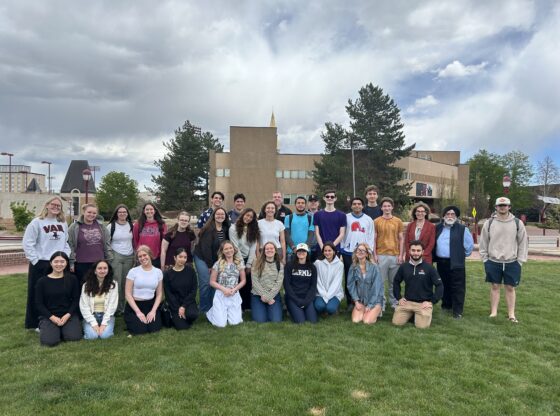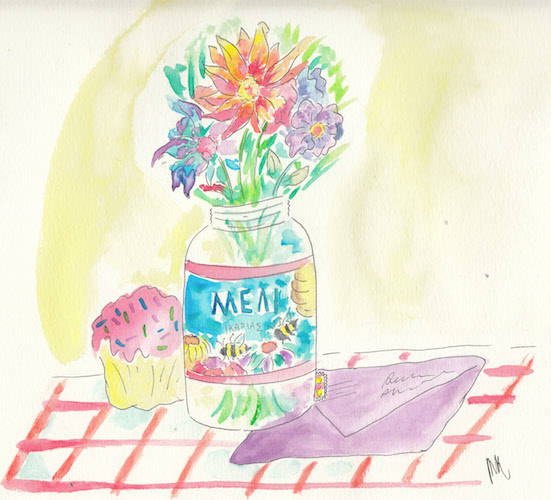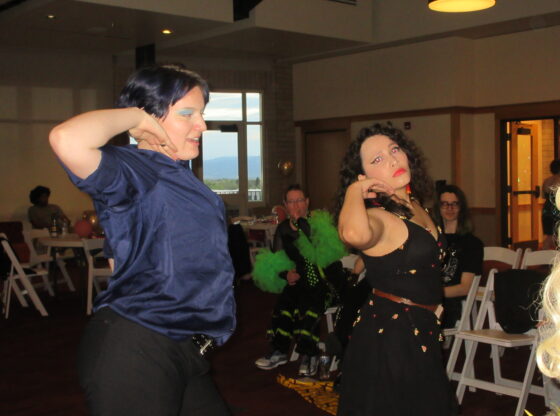On Sept. 28, DU’s Vicki Myhren Gallery opened “Gonkar Gyatso: Intimacy and Immediacy,” a new exhibit that will run until the end of fall quarter. The exhibit features over 300 doodles by Gonkar Gyatso, a Tibetan-born artist whose art merges traditional Buddhist iconography with modern references to current events, pop culture and politics.
Upon walking into the gallery, your attention will likely be drawn to the Buddha sculptures in the middle of each of the three rooms. Each wears a surgical-mask, establishing the context of the exhibit: the experience of the COVID-19 lockdown in China.
The description of the exhibit near the entrance efficiently introduces viewers to the chronological experience they will embark on of Gyatso’s casual daily works from 2018 to 2023. “Individually, these ‘daily doodles,’ as the artist calls them, appear disconnected, showcasing a wide range of subject matter, text, and composition. Yet, when viewed together, a narrative materializes. The emerging story alternates between boredom and panic, a quiet solitude contrasted by the frenetic pace of an unprecedented global pandemic,” wrote Sarah Magnatta, the curator of the exhibit.
Walk to the left and you start in pre-pandemic 2018 with the smallest collection of doodles from Gyatso’s sketchbook, about ten different drawings with variant but simple cultural content.
The drawings from 2019 begin to explore more complex political topics and incorporate aspects of multimedia work using stickers. Division is a repeated theme throughout this era of Gyatso’s work, with multiple drawings incorporating a visual that splits the two sides of the piece.
The year with the largest collection of drawings is 2020, when Gyatso began producing daily doodles with all of his newfound free time as China began lockdown in response to COVID-19.
While some of the drawings incorporate random imagery, the theme of the year is clear. From N95 masks, vaccination needles, hazmat suits and virus molecules to the empowered people in action at the center of the photos, the name of the exhibit begins to make sense. These works are Gyatso’s immediate and intimate response to the complexities and hazards of everyday life at a time of biological, political, social and ecological strife.
The 2020 drawings capture the communally felt emotions of fear, loss, confusion and frustration. The combination of pandemic-era visuals and imagery reflective of historical propaganda build a mosaic of political commentary based on the shared desire to escape a chaotic and unprecedented situation.
“Gyatso’s COVID-related drawings seem to alternate between the everyday norms of the moment, including social distancing and testing, and the human desire to break through, showcasing a communal anger at the havoc wrought by the virus,” said Magnatta in her essay reflection on Gyatso’s work that is available for sale at the gallery.
The collection from the “post-truth” era of 2021, as Gyatso wrote in one drawing, further divulges into the feelings of chaos and panic of this period. These drawings are more like collages, incorporating written components, advertisements, stickers and bright colors.
There is more to digest in these doodles because of the underlying political references, such as the inclusion of China’s Air Quality Index (AQI) as expressed by two conflicting sources. Gyatso captures government distrust, further emphasizing the confusion felt by Chinese people by obscuring the majority of faces that are included.
In 2022, Gyatso diverged from his previous traditional rectangular drawings and began to draw exclusively in circular shapes. The doodles are particularly colorful and busy but continue to reference politics, expressing the complex evolution of the hardships brought on by COVID-19.
“The circle’s telescopic appearance contributes to a compressed intensity — as if viewers are engaging these chaotic scenes through a constricted lens,” said Magnatta.
By 2023, the realities of COVID became normalized in Gyasto’s drawings, combining what had previously felt chaotic and overwhelming with new world phenomena like ChatGPT.
The Vicki Myhren Gallery’s exhibit, featuring the drawings of Gonkar Gyatso is a profound depiction of the reality of living through the global pandemic in China. By looking at Gyatso’s daily doodles, the audience gets insight into his lived experience and how it encouraged him to reflect on the world around him.
“These images of order — and its undoing — highlight an aspect rarely seen and appreciated in gallery and museum spaces: the intimacy and immediacy of the artist’s daily work,” said Magnatta.
The exhibit is open Tuesday through Sunday from noon to 5 p.m. and will run until Nov. 26th. Admission is free for DU students and affiliates.











